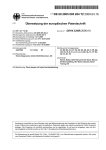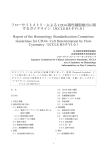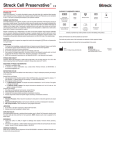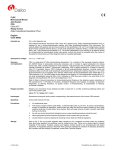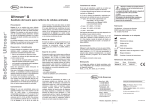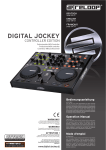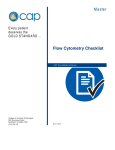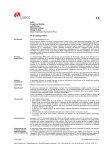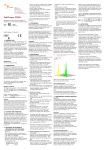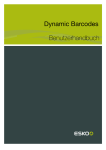Download CD-Chex TdT™ Plus
Transcript
CD-Chex TdT ™ Plus INSTRUCTIONS FOR USE INTENDED USE CD-Chex TdT™ Plus is intended to be used as a quality control material for evaluating intracellular and surface antigens, including TdT (Terminal deoxynucleotidyl transferase), CD1a, CD34 and Cytoplasmic CD3, with monoclonal antibody binding by flow cytometry. When these cells are stained with fluorescent antibodies and analyzed by flow cytometry, they provide a reference value for abnormal cells found in certain types of hematopoietic neoplasms. CD-Chex TdT Plus is designed for use on BD Biosciences and Beckman Coulter® flow cytometry systems. This product and the markers provided on the assay have not been cleared by the U.S. Food and Drug Administration for In Vitro Diagnostic use. This product and the values provided are For Research Use Only. Not for use in diagnostic procedures. SUMMARY AND PRINCIPLES Immunophenotyping by flow cytometry is a complex process. CD-Chex TdT Plus is designed to represent abnormal peripheral blood leukocytes consistent with a hematolymphoid neoplastic patient sample1,2,3. CD-Chex TdT Plus mimics whole blood samples by possessing surface antigens and intracellular antigens detectable with fluorescent monoclonal antibodies by flow cytometry. Stable antigens on CD-Chex TdT Plus include surface CD1a, CD2, CD4, CD5, CD7, CD8, CD34, intracellular CD3 and nuclear TdT. CD-Chex TdT Plus is a positive procedural assayed control used to monitor reagent staining, erythrocyte lysis, sample preparation, and instrument performance to provide consistent and reliable quality control measurements4. REAGENTS CD-Chex TdT Plus contains stabilized human blood and cells of human origin in a preservative medium. PRECAUTIONS 1. CD-Chex TdT Plus is For Research Use Only. Not for use in diagnostic procedures. 2. All human source material used to manufacture this product was non-reactive for antigens to Hepatitis B (HBsAg), negative by tests for antibodies to HIV (HIV-1/HIV-2) and Hepatitis C (HCV), non-reactive for HIV-1 RNA and HCV RNA by licensed NAT, and non-reactive to Serological Test for Syphilis (STS) using techniques specified by the U.S. Food and Drug Administration. Because no known test method can assure complete absence of human pathogens, this product should be handled with appropriate precautions. 3. This product should not be disposed in general waste, but should be disposed with infectious medical waste. Disposal by incineration is recommended. 4. This product is intended for use as supplied. Adulteration by dilution or addition of any materials to the product as supplied invalidates the intended use of the product. 5. CD-Chex TdT Plus should not to be used as calibrator. STORAGE AND STABILITY CD-Chex TdT Plus is stable through the expiration date when stored at 2 °C to 10 °C. After opening, the product is stable throughout the open-vial dating, as indicated on the assay sheet, when stored at 2 °C to 10 °C. DO NOT FREEZE. INDICATIONS OF PRODUCT DETERIORATION Inability to obtain expected values may indicate product deterioration. If the recovered values are not within the expected ranges: 1. Review control product package insert and the operating procedure of the instrument. 2. Check expiration date of the product on the vial. Discard outdated products. 3. Assay an unopened vial of the CD-Chex TdT Plus. If the values are still outside the expected range, contact Streck Technical Services at 800-843-0912 or [email protected]. INSTRUCTIONS FOR USE 1. Follow instrument manufacturer’s instructions for instrument compensation and sample analysis. 2. Remove a vial of the control from refrigerator and warm to room temperature (18 °C to 30 °C) for 15 minutes before use. 3. To mix: a. Hold horizontally between palms of the hands and roll the vial back and forth for 20 to 30 seconds. b. Mix by gentle inversion at least 8-10 times until all cells are thoroughly suspended. c. Gently invert the vial 5 times immediately before sampling. Note: Vials stored for an extended period of time may require extra mixing. 4. Aliquot appropriate volume of control reagent into each tube and return to refrigeration to ensure maximum open vial stability. 5. Add recommended monoclonal antibodies according to manufacturer’s instructions to each tube and mix gently. Note: A negative staining control is recommended due to heterogeneous/dim expression of selected assayed parameters. 6. Incubate according to antibody manufacturer’s instructions. 7. Add recommended amount of RBC lysing agent according to manufacturer’s instructions. 8. Analyze by flow cytometry in the same manner as patient samples. INTRACELLULAR MARKER INSTRUCTIONS FOR USE Follow steps 1-3 above. CD-Chex TdT Plus is stabilized cellular material. Therefore, the fixation step (Reagent 1 or Reagent A) used prior to permeabilization in commercially available intracellular staining kits is not required. Use of the fixation reagent will result in sub-optimal recovery. LIMITATIONS CD-Chex TdT Plus is not intended to be used in ISHAGE protocols for CD34 enumeration. Staining characteristics are not equivalent to the phenotypic properties of human hematopoietic progenitor cells5,6. EXPECTED RESULTS The mean values provided are derived from replicate analyses on properly compensated flow cytometers. The assay values are obtained using reagents recommended by each instrument manufacturer. The expected ranges listed represent estimates of variation due to different laboratories’ reagents, instrument performance, maintenance, and operator technique. It is recommended that an individual laboratory establish its own control means and ranges for each parameter and sample analyzed that reflect the laboratory’s specific conditions and protocols. These established control means should fall within the published expected ranges. Data collected from interlaboratory quality control programs can be used as a cumulative approach when calculating ranges. GATING The most common gating strategy used in neoplastic cell assessment is to gate on the abnormal cells and then determine the CD marker percent positivity using a negative staining control1-4. Abnormal cells are generally located on a FSC/SSC plot or a CD45/SSC plot; although other gating strategies can be employed1-4. Debris should be excluded from the cell gate to obtain percent recovery values within assay range. A. B. FIGURE 1. Gating methods used to identify abnormal cells. In CD-Chex TdT Plus, abnormal cells can be identified using standard gating strategies: FSC/SSC (A. Rectangle Gate) or CD45/SSC (B. Oval Gate). Optimal gates will remove debris for evaluation of percent recovery. REFERENCES 1. Gorczyca, W. Flow cytometry in neoplastic hematology. Morphologic-Immunophenotypic Correlation - Second Edition, Informa Healthcare, New York, NY USA, 2010. 2. Cheria, S., Wood, B. Flow cytometry in hematopoietic neoplasms; A case-based approach. CAP Press, Northfield, IL USA, 2012. 3. Nguyen, D., Diamond, L.W., Braylan, R.C. Flow cytometry in hematopathology, a visual approach to data analysis and interpretation. Second Edition, Humana Press, Totowa, NJ USA, 2007. 4. Clinical and Laboratory Standards Institute, H43-A2, Clinical flow cytometric analysis of neoplastic hematolymphoid cells. Approved Guideline - Second Edition, Wayne, PA USA, 2009. 5. Clinical and Laboratory Standards Institute, H42-A2, Enumeration of immunologically defined cell populations by flow cytometry. Approved Guideline - Second Edition. Wayne, PA USA, 2007. 6. Sutherland, D.R., Anderson L., Keeney, M., Nayar, R., Chin-Yee, I. The ISHAGE guidelines for CD34+ cell determination by flow cytometry. J Hematotherapy 1996; 5: 213-226. QUALITY CONTROL PROGRAM Streck offers STATS®, an interlaboratory quality control program, to all customers at no charge. For more information, contact the STATS Department at 800-898-9563 or [email protected]. Additional information can be found at www.streck.com. ORDERING INFORMATION Please call our Customer Service Department toll free 800-228-6090 for assistance. Additional information can be found online at www.streck.com. GLOSSARY OF HARMONIZED SYMBOLS LOT Batch Code REF Biological Risk Catalog Number Use By Manufacturer Consult Instructions For Use Temperature Limitation Glossary of symbols may contain symbols not used in the labeling of this product. See www.streck.com/patents for patents that may be applicable to this product. The brand and product names of the instruments are trademarks of their respective holders. Streck 7002 S. 109 Street Omaha, NE 68128 USA 350651-1 2015-06 MODE D’EMPLOI French (Francąis) UTILISATION PRÉVUE ™ CD-Chex TdT Plus est destiné à être utilisé comme un contrôle de la qualité permettant de quantifier les antigènes intracellulaires et de surface, notamment la TdT (transférase terminale), le CD1a, le CD34 et le CD3 cytoplasmique, par fixation à des anticorps monoclonaux par cytométrie en flux. Quand ces cellules sont marquées avec des anticorps fluorescents, puis analysées par cytométrie de flux, elles fournissent un niveau de référence pour les cellules anormales qui se trouvent dans certains types de néoplasmes hématopoïétiques. CD-Chex TdT Plus a été conçu pour être utilisé avec les systèmes de cytométrie en flux de BD Biosciences et de Beckman Coulter®. Ce produit et les marqueurs fournis avec le dosage n’ont pas reçu l’autorisation de l’U.S. Food and Drug Administration pour une utilisation diagnostique in vitro. Ce produit et les valeurs fournies sont réservés à la recherche. Utilisation interdite dans les procédures diagnostiques. RÉSUMÉ ET PRINCIPES L’immunophénotypage par cytométrie en flux est une méthode complexe. CD-Chex TdT Plus est destiné à représenter des leucocytes anormaux du sang périphérique cohérents avec un échantillon patient néoplasique hématolymphoïde.1,2,3 CD-Chex TdT Plus imite des échantillons de sang total en possédant des antigènes de surface et des antigènes intracellulaires détectables avec des anticorps monoclonaux fluorescents par cytométrie en flux. Les antigènes stables sur CD-Chex TdT Plus incluent les CD1a, CD2, CD4, CD5, CD7, CD8, CD34 de surface, le CD3 intracellulaire et la Tdt nucléaire. CD-Chex TdT Plus est un contrôle positif de dosage qui permet de surveiller la réaction à la coloration, la lyse érythrocytaire, la préparation des échantillons et la performance des instruments afin de fournir des mesures de contrôle de la qualité cohérentes et fiables4. Il est recommandé que chaque laboratoire définisse ses propres moyennes et intervalles de contrôle pour chaque paramètre et chaque échantillon analysé qui reflètent les conditions et les protocoles spécifiques du laboratoire. Ces valeurs moyennes de contrôle établies doivent se situer dans les intervalles escomptés publiés. Les données recueillies auprès des programmes de contrôle qualité interlaboratoires pourront servir d’approche cumulative lors du calcul des intervalles. FENÊTRAGE La stratégie de fenêtrage la plus courante utilisée dans l’évaluation de cellules néoplasiques consiste à fenêtrer les cellules anormales, puis à déterminer le pourcentage de positivité pour le marqueur CD en utilisant un contrôle de coloration négatif.1-4 Les cellules anormales se trouvent généralement avec un cytogramme FSC/SSC ou CD45/SSC, même si d’autres stratégies de fenêtrage peuvent être employées.1-4 Afin d’obtenir des pourcentages de recouvrement compris dans l’intervalle, il faut exclure les débris de la fenêtre des cellules. A. B. RÉACTIFS CD-Chex TdT Plus contient du sang humain et des cellules d’origine humaine stabilisés dans un milieu de conservation. PRÉCAUTIONS 1. CD-Chex TdT Plus est réservé à la recherche. Utilisation interdite dans les procédures diagnostiques. 2. Tout produit d’origine humaine utilisé pour fabriquer ce produit s’est montré non réactif vis-à-vis des antigènes du virus de l’hépatite B (HBsAg) et négatif aux tests de dépistage d’anticorps anti-VIH (VIH-1/ VIH-2) et anti-hépatite C (HCV), non réactif au dépistage ARN VIH-1 et HCV par TAN sous licence et non réactif au dépistage sérologique de la syphilis (STS) par les techniques spécifiées par la U.S. Food and Drug Administration. Comme aucune méthode de test connue ne peut assurer l’absence totale d’agents pathogènes humains, ce produit doit être manipulé en prenant les précautions appropriées. 3. Ce produit ne doit pas être mis au rebut avec les déchets ordinaires, mais avec les déchets médicaux infectieux. Une élimination par incinération est recommandée. 4. Ce produit doit être utilisé tel qu’il est été fourni. La dilution ou le mélange avec toute autre substance invalidera l’usage prévu pour ce produit. 5. CD-Chex TdT Plus ne doit pas être utilisé comme calibrateur. CONSERVATION ET STABILITÉ Le CD-Chex TdT Plus est stable jusqu’à la date de péremption lorsqu’il est conservé entre 2 et 10 oC. Après ouverture, CD-Chex TdT Plus reste stable jusqu’à la date limite indiquée sur la notice de dosage, à condition d’être conservé entre 2 et 10 oC. NE PAS CONGELER. INDICATIONS DE DÉTÉRIORATION DU PRODUIT L’impossibilité d’obtention des valeurs escomptées peut indiquer une détérioration du produit. Si les valeurs obtenues ne se situent pas dans les intervalles escomptés : 1. Lire la notice d’utilisation du produit de contrôle et le mode d’emploi de l’instrument. 2. Vérifier la date de péremption du produit sur le flacon. Jeter les produits périmés. 3. Répéter le dosage avec un flacon non ouvert de CD-Chex TdT Plus. Si les valeurs se situent toujours hors de l’intervalle escompté, contacter le service technique de Streck au +1 402-691-7510 ou envoyer un courriel à l’adresse [email protected]. MODE D’EMPLOI 1. Pour la compensation de l’instrument et l’analyse des échantillons, suivre les instructions du fabricant de l’instrument. 2. Retirer un flacon de contrôle du réfrigérateur et le laisser s’adapter à la température ambiante (18 à 30 °C) pendant 15 minutes avant usage. 3. Pour mélanger : a. Tenir le flacon à l’horizontale entre les paumes des mains et le rouler entre les mains pendant 20 à 30 secondes. b. Mélanger en retournant délicatement 8 à 10 fois minimum, jusqu’à ce que toutes les cellules soient en suspension. c. Retourner délicatement le flacon 5 fois, juste avant l’échantillonnage. Remarque : Les flacons conservés pendant une période prolongée pourront exiger un mélange supplémentaire. 4. Verser le volume approprié de réactif de contrôle dans chaque tube et remettre au réfrigérateur pour maximiser la stabilité des flacons ouverts. 5. Ajouter les anticorps monoclonaux recommandés dans chaque tube en suivant les instructions du fabricant et mélanger délicatement. Remarque : un contrôle de coloration négatif est recommandé en raison de l’expression hétérogène/faible des paramètres de dosage sélectionnés. 6. Laisser incuber en suivant les instructions du fabricant des anticorps. 7. Ajouter la quantité recommandée d’agent hémolysant érythrocytaire en suivant les instructions du fabricant. 8. Analyser par cytométrie de flux d’une manière identique à celle utilisée pour les échantillons de patients. INSTRUCTIONS D’UTILISATION POUR DES MARQUEURS INTRACELLULAIRES Suivre les étapes 1 à 3 ci-dessus. CD-Chex TdT Plus est un produit cellulaire stabilisé. Par conséquent, l’étape de fixation (Réactif 1 ou A) utilisée avant la perméabilisation dans les trousses de marquage intracellulaire commercialisées n’est pas requise. L’emploi du réactif de fixation se soldera par un recouvrement sous-optimal. RESTRICTIONS CD-Chex TdT Plus n’est pas destiné à être utilisé dans les protocoles ISHAGE pour la numération des CD34. Les caractéristiques de coloration ne sont pas équivalentes aux propriétés phénotypes des cellules progénitrices hématopoïétiques humaines.5,6 RÉSULTATS ESCOMPTÉS Les valeurs de dosage moyennes fournies sont dérivées d’analyses en parallèle, réalisées sur des cytomètres de flux correctement compensés. Les valeurs de dosage sont obtenues en utilisant les réactifs recommandés par le fabricant de chaque instrument. Les intervalles escomptés répertoriés représentent des estimations d’écart en raison des différents réactifs utilisés par les laboratoires, de la performance et de la maintenance de l’instrument et de la technique utilisée par l’opérateur. FIGURE 1. Méthodes de fenêtrage utilisées pour identifier les cellules anormales. Avec CD-Chex TdT Plus, les cellules anormales sont identifiées à l’aide de stratégies de fenêtrage standards : FSC/SSC (A. Fenêtre rectangulaire) ou CD45/SSC (B. Fenêtre ovale). Les fenêtres optimales enlèveront les débris afin d’évaluer le recouvrement en pourcentage. RÉFÉRENCES 1. Gorczyca, W. Flow cytometry in neoplastic hematology. Morphologic-Immunophenotypic Correlation Second Edition, Informa Healthcare, New York, NY USA, 2010. 2. Cheria, S., Wood, B. Flow cytometry in hematopoietic neoplasms; A case-based approach. CAP Press, Northfield, IL USA, 2012. 3. Nguyen, D., Diamond, L.W., Braylan, R.C. Flow cytometry in hematopathology, a visual approach to data analysis and interpretation. Second Edition, Humana Press, Totowa, NJ USA, 2007. 4. Clinical and Laboratory Standards Institute, H43-A2, Clinical flow cytometric analysis of neoplastic hematolymphoid cells. Approved Guideline - Second Edition, Wayne, PA USA, 2009. 5. Clinical and Laboratory Standards Institute, H42-A2, Enumeration of immunologically defined cell populations by flow cytometry. Approved Guideline - Second Edition. Wayne, PA USA, 2007. 6. Sutherland, D.R., Anderson L., Keeney, M., Nayar, R., Chin-Yee, I. The ISHAGE guidelines for CD34+ cell determination by flow cytometry. J Hematotherapy 1996; 5: 213-226. PROGRAMME DE CONTRÔLE DE LA QUALITÉ Streck fournit gratuitement à tous ses clients le programme de contrôle qualité interlaboratoires STATS®. Pour obtenir plus de renseignements, contacter le service STATS au +1 402-691-7495 ou à [email protected]. Pour plus d’informations, consultez le site www.streck.com. INFORMATIONS CONCERNANT LES COMMANDES Pour obtenir de l’aide, contacter le service clientèle au +1 402-333-1982. Pour plus d’informations, consultez le site www.streck.com. Consulter le site www.streck.com/patents pour les brevets qui pourraient concerner ce produit. Les noms de marque et de produit des instruments sont des marques de commerce de leurs détenteurs respectifs. GEBRAUCHSANWEISUNG German (Deutsch) VERWENDUNGSZWECK ™ CD-Chex TdT Plus ist als Qualitätskontrollmaterial zur Beurteilung von intrazellulären und Oberflächenantigenen bestimmt, darunter TdT (terminale Desoxyribonukleotidyltransferase) CD1a, CD34 und zytoplasmatisches CD3, mit Bindung monoklonaler Antikörper mittels Durchflusszytometrie. Wenn diese Zellen mit FluoreszenzAntikörpern markiert und mittels Durchflusszytometrie analysiert werden, liefern sie einen Bezugswert für anomale Zellen in bestimmten Arten von hämatopoetischen Neoplasmen. CD-Chex TdT Plus ist zur Verwendung mit Durchflusszytometriesystemen von BD Biosciences und Beckman Coulter® konzipiert. Dieses Produkt und die auf dem Assay bereitgestellten Marker sind von der US-amerikanischen Food and Drug Administration nicht zum diagnostischen Einsatz in vitro zugelassen. Dieses Produkt und die angegebenen Werte sind ausschließlich zu Forschungszwecken bestimmt. Nicht zur Verwendung bei diagnostischen Verfahren. ZUSAMMENFASSUNG UND GRUNDLAGEN Die Immunophänotypisierung mittels Durchflusszytometrie ist ein komplexes Verfahren. CD-Chex TdT Plus soll anomale periphere Blutleukozyten darstellen, die mit einer hämatolymphoiden neoplastischen Patientenprobe übereinstimmen1,2,3. CD-Chex TdT Plus ahmt Vollblutproben nach, weil es Oberflächenantigene und intrazelluläre Antigene enthält, die mit fluoreszenten monoklonalen Antikörpern mittels Durchflusszytometrie erkannt werden können. Stabile Antigene auf CD-Chex TdT Plus umfassen Oberflächen-CD1a, CD2, CD4, CD5, CD7, CD8, CD34, intrazellulares CD3 und nukleare TdT. CD-Chex TdT Plus ist eine Positivverfahren-Assay-Kontrolle zur Beobachtung der Reagenzfärbung, Erythrozytenlyse, Probenpräparation und Instrumentenfunktion zur Bereitstellung einheitlicher und zuverlässiger Qualitätskontrollmaße4. REAGENZIEN CD-Chex TdT Plus enthält stabilisiertes Humanblut und Zellen humanen Ursprungs in einem Konservierungsmittel. VORSICHTSMASSNAHMEN 1. CD-Chex TdT Plus ist ausschließlich für Forschungszwecke bestimmt. Nicht zur Verwendung bei diagnostischen Verfahren. 2. Sämtliches zur Herstellung dieses Produkts verwendetes humanes Ausgangsmaterial war nicht reaktiv auf Antigene für Hepatitis B (HBsAg) und negativ bei Tests auf Antikörper gegen HIV (HIV-1/HIV-2) und Hepatitis C (HCV) sowie nicht reaktiv auf HIV-1-RNA und HCV-RNA gemäß lizenziertem NAT-Nachweis sowie nicht reaktiv bei serologischen Syphilistests (STS). Dies wurde mithilfe von Methoden getestet, die von der US-amerikanischen Food and Drug Administration vorgegeben werden. Da keine Testmethode bekannt ist, welche die vollständige Abwesenheit von menschlichen Pathogenen ausschließen kann, sollte dieses Produkt mit den entsprechenden Vorsichtsmaßnahmen gehandhabt werden. 3. Dieses Produkt sollte nicht mit dem allgemeinen Müll, sondern als infektiöser medizinischer Abfall entsorgt werden. Es wird eine Entsorgung durch Verbrennen empfohlen. 4. Dieses Produkt darf nur wie geliefert verwendet werden. Veränderungen durch Verdünnen oder Zusetzen von Substanzen zum Lieferprodukt machen dieses für seinen Verwendungszweck untauglich. 5. CD-Chex TdT Plus darf nicht als Kalibrator verwendet werden. LAGERUNG UND STABILITÄT Bei 2 °C bis 10 °C bleibt CD-Chex TdT Plus bis einschließlich Verfallsdatum stabil. Nach dem Anbrechen bleibt das Produkt bis einschließlich Verfallsdatum für das angebrochene Fläschchen stabil (siehe Analyseblatt), sofern es bei 2 °C bis 10 °C gelagert wird. NICHT EINFRIEREN. ANZEICHEN EINER QUALITÄTSMINDERUNG Ist die Erzielung der erwarteten Werte nicht möglich, kann dies auf eine Qualitätsminderung des Produkts hindeuten. Falls die gemessenen Werte nicht im erwarteten Bereich liegen: 1. Die Packungsbeilage des Kontrollprodukts und das Betriebsverfahren für das Gerät überprüfen. 2. Das Verfallsdatum des Produkts auf dem Fläschchen überprüfen. Produkte, deren Verfallsdatum überschritten ist, entsorgen. 3. Ein ungeöffnetes Fläschchen CD-Chex TdT Plus analysieren. Liegen die Werte noch immer außerhalb des erwarteten Bereichs, wenden Sie sich an den technischen Kundendienst von Streck unter der Nummer 402-691-7510 oder unter [email protected]. GEBRAUCHSANWEISUNG 1. Die Anweisungen des Geräteherstellers bezüglich Gerätekompensation und Probenanalyse befolgen. 2. Ein Kontrollfläschchen aus dem Kühlschrank nehmen und vor Gebrauch 15 Minuten lang bis auf Zimmertemperatur (18-30 °C) anwärmen. 3. Zum Mischen: a. Das Fläschchen horizontal zwischen den Handflächen halten und 20 bis 30 Sekunden lang hin und her rollen. b. Zum Mischen mindestens 8 bis 10 Mal behutsam über Kopf drehen, bis alle Zellen gut suspendiert sind. c. Unmittelbar vor der Probennahme das Fläschchen vorsichtig 5 Mal über Kopf drehen. Hinweis: Länger gelagerte Fläschchen benötigen u. U. weiteres Mischen. 4. Das passende Volumen an Kontrollreagenz in jedes Probenröhrchen aliquotieren und zurück in den Kühlschrank stellen, um die maximale Stabilität für offene Reagenzgläser sicherzustellen. 5. Gemäß Herstelleranweisungen jedem Röhrchen die empfohlenen monoklonalen Antikörper hinzufügen und behutsam mischen. Hinweis: Aufgrund der heterogenen/schwachen Expression bestimmter analysierter Parameter wird die Verwendung einer negativen Färbekontrolle empfohlen. 6. Gemäß den Anweisungen des Antikörperherstellers inkubieren. 7. Die empfohlene Menge Erythrozyten-Lysierreagenz hinzufügen, wie vom Hersteller angegeben. 8. Mittels Durchflusszytometrie in der gleichen Weise analysieren wie Patientenproben. GEBRAUCHSANWEISUNG FÜR INTRAZELLULÄRE MARKER Schritte 1 bis 3 oben befolgen. CD-Chex TdT Plus wird in zellulärem Material stabilisiert. Deshalb entfällt der Fixierungsschritt (Reagenz 1 oder Reagenz A) vor der Permeabilisierung bei handelsüblichen Intrazellulärfärbekits. Die Verwendung des Fixierungsreagenz führt zu einer suboptimalen Gewinnung. EINSCHRÄNKUNGEN CD-Chex TdT Plus ist nicht zur Verwendung bei ISHAGE-Protokollen für die CD34-Bestimmung konzipiert. Die Färbeeigenschaften entsprechen nicht den phänotypischen Eigenschaften humaner hämatopoetischer Vorläuferzellen5,6. ERWARTETE ERGEBNISSE Die für jeden Parameter angegebenen Durchschnittswerte sind aus replizierten Analysen auf vorschriftsmäßig kompensierten Zytometern abgeleitet. Diese Analysewerte werden unter Verwendung von Reagenzien ermittelt, die vom jeweiligen Instrumentenhersteller empfohlen werden. Die angegebenen erwarteten Bereiche stellen Schätzungen der Schwankungen dar, die sich aufgrund von unterschiedlichen Reagenzien in verschiedenen Laboren sowie durch unterschiedliche Geräteleistung, Wartung und Bedienertechnik ergeben können. Es wird empfohlen, dass das betreffende Labor für jeden Parameter und jede analysierte Probe seine eigenen Mittel- und Grenzwerte etabliert, die den spezifischen Bedingungen und Protokollen des Labors entsprechen. Diese festgelegten Kontrollmittelwerte sollten in die veröffentlichten erwarteten Bereiche fallen. Die im Rahmen von Interlabor-Qualitätsprogrammen erfassten Daten können bei der Berechnung von Wertebereichen als kumulativer Ansatz dienen. EINGRENZUNG Die häufigste Eingrenzungsstrategie zur Beurteilung neoplastischer Zellen ist die Eingrenzung der anomalen Zellen und die Ermittlung des Anteils an CD-Marker-positiven Zellen anhand einer negativen Färbekontrolle1-4. Anomale Zellen werden in der Regel mit einem FSC/SSC Plot oder einem CD45/SSC Plot ausfindig gemacht, obwohl auch andere Eingrenzungsstrategien angewendet werden können1-4. Trümmer sind von der Zelleneingrenzung auszuschließen, um Anteilsmesswerte zu erhalten, die im Assay-Wertebereich liegen. A. B. ABBILDUNG 1. Zur Erkennung anomaler Zellen eingesetzte Eingrenzungsmethoden Mit CD-Chex TdT Plus können anomale Zellen mit standardmäßigen Eingrenzungsstrategien bestimmt werden: FSC/SSC (A. rechteckiges Gate) oder CD45/SSC (B. ovales Gate). Optimale Eingrenzungen entfernen Trümmer zur Bewertung des gemessenen Anteils. QUELLENANGABEN 1. Gorczyca, W. Flow cytometry in neoplastic hematology. Morphologic-Immunophenotypic Correlation Second Edition, Informa Healthcare, New York, NY USA, 2010. 2. Cheria, S., Wood, B. Flow cytometry in hematopoietic neoplasms; A case-based approach. CAP Press, Northfield, IL USA, 2012. 3. Nguyen, D., Diamond, L.W., Braylan, R.C. Flow cytometry in hematopathology, a visual approach to data analysis and interpretation. Second Edition, Humana Press, Totowa, NJ USA, 2007. 4. Clinical and Laboratory Standards Institute, H43-A2, Clinical flow cytometric analysis of neoplastic hematolymphoid cells. Approved Guideline - Second Edition, Wayne, PA USA, 2009. 5. Clinical and Laboratory Standards Institute, H42-A2, Enumeration of immunologically defined cell populations by flow cytometry. Approved Guideline - Second Edition. Wayne, PA USA, 2007. 6. Sutherland, D.R., Anderson L., Keeney, M., Nayar, R., Chin-Yee, I. The ISHAGE guidelines for CD34+ cell determination by flow cytometry. J Hematotherapy 1996; 5: 213-226. PROGRAMM ZUR QUALITÄTSSICHERUNG Streck stellt allen Kunden kostenlos das Interlabor-Qualitätskontrollprogramm STATS® zur Verfügung. Näheres erfahren Sie bei der STATS-Abteilung unter 402-691-7495 oder [email protected]. Zusätzliche Informationen sind unter www.streck.com erhältlich. BESTELLINFORMATIONEN Unterstützung bietet unsere Kundendienstabteilung unter der US-Rufnummer +1 402-333-1982. Zusätzliche Informationen sind online unter www.streck.com erhältlich. Eventuell auf dieses Produkt zutreffende Patente finden Sie unter www.streck.com/patents. Die Marken- und Produktnamen der Geräte sind Marken ihrer jeweiligen Inhaber. ISTRUZIONI PER L’USO Italian (Italiano) USO PREVISTO ™ CD-Chex TdT Plus è indicato per l’utilizzo come materiale di controllo di qualità nella valutazione degli antigeni intracellulari e di superficie, inclusi TdT (Terminal Deossinucleotidil-Transferasi), CD1a, CD34 e CD3 citoplasmatico, con legame di anticorpi monoclonali eseguita tramite citometria a flusso. Quando sono marcate con anticorpi fluorescenti e analizzate in citometria a flusso, queste cellule fungono da valore di riferimento per le cellule anomale che si ritrovano in alcuni tipi di neoplasie ematopoietiche. CD-Chex TdT Plus è progettato per essere usato nei sistemi di citometria a flusso BD Biosciences e Beckman Coulter®. Questo prodotto e i marker forniti nell’analisi non sono stati approvati dall’agenzia statunitense Food and Drug Administration per uso diagnostico in vitro. Il prodotto e i valori forniti devono essere utilizzati esclusivamente a fini di ricerca. Da non utilizzare in procedure diagnostiche. RIEPILOGO E PRINCIPI L’immunofenotipizzazione mediante citometria a flusso è un processo complesso. CD-Chex TdT Plus è progettato per rappresentare leucociti anomali nel sangue periferico compatibili con il campione di un paziente affetto da neoplasie emato-linfoidi1,2,3. CD-Chex TdT Plus riproduce i campioni di sangue intero in quanto possiede antigeni di superficie e antigeni intracellulari rilevabili con anticorpi monoclonali fluorescenti mediante citometria a flusso. Gli antigeni stabili presenti sul CD-Chex TdT Plus includono CD1a, CD2, CD4, CD5, CD7, CD8, CD34 superficiali, CD3 intracellulare e TdT nucleare. CD-Chex TdT Plus è un controllo procedurale positivo testato, da utilizzare per monitorare la colorazione di reagenti, la lisi eritrocitaria, la preparazione dei campioni e la performance degli strumenti, per dare misurazioni di controllo di qualità coerenti e affidabili4. Si raccomanda ai laboratori di applicare le proprie misure di controllo e definire appropriati intervalli per ciascun parametro e campione analizzato che riflettano le specifiche condizioni e i protocolli in uso nel laboratorio. Queste misure di controllo devono essere comprese negli intervalli attesi pubblicati. I dati raccolti dai programmi interlaboratorio di controllo della qualità possono essere utilizzati come approccio cumulativo al calcolo degli intervalli. GATING La più comune strategia di gating usata nella valutazione delle cellule neoplastiche consiste nell’eseguire un gating su cellule anomale e quindi determinare la positività percentuale del marcatore CD usando un controllo a colorazione negativa1-4. Le cellule anomale sono generalmente localizzate su un diagramma FSC/SSC o un diagramma CD45/SSC, sebbene possano essere impiegate altre strategie di gating1-4. Per ottenere valori percentuali di recupero rientranti nell’intervallo di analisi, è necessario escludere le particelle dal gating delle cellule. A. B. REAGENTI CD-Chex TdT Plus contiene sangue umano stabilizzato e cellule di origine umana in una soluzione conservante. PRECAUZIONI 1. CD-Chex TdT Plus deve essere utilizzato esclusivamente a fini di ricerca. Da non utilizzare in procedure diagnostiche. 2. Tutto il materiale di origine umana usato per la realizzazione di questo prodotto è risultato non reattivo agli antigeni dell’epatite B (HBsAg), negativo ai test anticorpali per HIV (HIV-1/HIV-2) ed epatite C (HCV), non reattivo a RNA di HIV-1 e RNA di HCV con test NAT autorizzato, e non reattivo al test sierologico per la sifilide (STS), test eseguiti con le metodiche specificate dall’agenzia statunitense Food and Drug Administration. Poiché nessun metodo di analisi è in grado di assicurare la completa assenza di agenti patogeni umani, questo prodotto deve essere manipolato con le opportune precauzioni. 3. Il prodotto non deve essere smaltito con i normali rifiuti, ma insieme ai rifiuti medici infetti. Si raccomanda lo smaltimento mediante incenerimento. 4. Questo prodotto è destinato all’uso così come fornito. La sua adulterazione mediante diluizione o aggiunta di altri materiali ne invalida l’uso previsto. 5. Non utilizzare CD-Chex TdT Plus come calibratore. CONSERVAZIONE E STABILITÀ CD-Chex TdT Plus è stabile fino alla data di scadenza, purché conservato ad una temperatura compresa fra 2 °C e 10 °C. Una volta aperto, il prodotto è stabile fino alla data di scadenza per la fiala aperta indicata sul foglio di analisi, purché conservato ad una temperatura compresa fra 2 °C e 10 °C. NON CONGELARE. SEGNI DI DETERIORAMENTO DEL PRODOTTO L’impossibilità di ottenere i valori previsti può essere indice di deterioramento del prodotto. Se i valori ottenuti non rientrano negli intervalli attesi: 1. Rivedere l’inserto della confezione del prodotto di controllo e la procedura operativa dello strumento. 2. Controllare la data di scadenza del prodotto sulla fiala. Eliminare i prodotti scaduti. 3. Analizzare una fiala sigillata di CD-Chex TdT Plus. Se i valori sono ancora al di fuori dell’intervallo previsto, rivolgersi al servizio di assistenza tecnica Streck al numero +1 402-691-7510 oppure visitare il sito [email protected]. ISTRUZIONI PER L’USO 1. Seguire le istruzioni del produttore dello strumento utilizzato per quanto riguarda la compensazione dello strumento e l’analisi dei campioni. 2. Rimuovere una fiala di controllo dal frigorifero e lasciarla a temperatura ambiente (18 °C - 30 °C) per 15 minuti prima dell’uso. 3. Per miscelare: a. Tenere la fiala in posizione orizzontale fra i palmi delle mani e farla rotolare in avanti e indietro per 20-30 secondi. b. Miscelare mediante inversione leggera almeno 8-10 volte fino a quando tutte le cellule non sono completamente sospese. c. Capovolgere delicatamente la fiala 5 volte immediatamente prima del campionamento. Nota: le fiale conservate per un lungo periodo di tempo possono richiedere una miscelazione più lunga. 4. Aliquotare un volume appropriato di reagente di controllo in ogni provetta e riporlo in frigorifero per assicurare la massima stabilità della fiala aperta. 5. Seguendo le istruzioni del produttore, aggiungere la quantità di anticorpi monoclonali consigliata in ogni provetta e miscelare delicatamente. Nota: si consiglia un controllo a colorazione negativa a causa dell’espressione eterogenea/indistinta di alcuni parametri analizzati. 6. Incubare secondo le istruzioni del produttore degli anticorpi. 7. Aggiungere la quantità consigliata di agente lisante per GR secondo le istruzioni del produttore. 8. Analizzare mediante citometria a flusso allo stesso modo dei campioni clinici. ISTRUZIONI PER L’USO DEI MARKER INTRACELLULARI Ripetere i punti 1-3 sopra descritti. CD-Chex TdT Plus è costituito da materiale cellulare stabilizzato. Non è pertanto necessaria la fase di fissazione (Reagente 1 o Reagente A) usata prima della permeabilizzazione nei kit di colorazione intracellulare in commercio. L’uso del reagente di fissazione dà luogo a un recupero subottimale. LIMITAZIONI CD-Chex TdT Plus non è previsto per essere usato in protocolli ISHAGE per l’enumerazione di CD34. Le caratteristiche di colorazione non sono equivalenti alle proprietà fenotipiche delle cellule progenitrici ematopoietiche umane5,6. RISULTATI ATTESI I valori medi forniti sono stati ricavati da analisi replicate su citofluorimetri adeguatamente compensati. I valori di analisi sono stati ottenuti usando i reagenti raccomandati dai produttori di ciascuno strumento. Gli intervalli previsti elencati rappresentano le stime di variazione che si ottengono a causa della differenza fra laboratori, il funzionamento dello strumento, la manutenzione e la tecnica dell’operatore. FIGURA 1 - Metodi di gating utilizzati per identificare cellule anomale. In CD-Chex TdT Plus, le cellule anomale possono essere identificate utilizzando strategie standard di gating: FSC/SSC (A. Gate rettangolare) o CD45/SSC (B. Gate ovale). I gate ottimali rimuoveranno le particelle al fine della valutazione della percentuale di recupero. BIBLIOGRAFIA 1. Gorczyca, W. Flow cytometry in neoplastic hematology. Morphologic-Immunophenotypic Correlation Second Edition, Informa Healthcare, New York, NY USA, 2010. 2. Cheria, S., Wood, B. Flow cytometry in hematopoietic neoplasms; A case-based approach. CAP Press, Northfield, IL USA, 2012. 3. Nguyen, D., Diamond, L.W., Braylan, R.C. Flow cytometry in hematopathology, a visual approach to data analysis and interpretation. Second Edition, Humana Press, Totowa, NJ USA, 2007. 4. Clinical and Laboratory Standards Institute, H43-A2, Clinical flow cytometric analysis of neoplastic hematolymphoid cells. Approved Guideline - Second Edition, Wayne, PA USA, 2009. 5. Clinical and Laboratory Standards Institute, H42-A2, Enumeration of immunologically defined cell populations by flow cytometry. Approved Guideline - Second Edition. Wayne, PA USA, 2007. 6. Sutherland, D.R., Anderson L., Keeney, M., Nayar, R., Chin-Yee, I. The ISHAGE guidelines for CD34+ cell determination by flow cytometry. J Hematotherapy 1996; 5: 213-226. PROGRAMMA DI CONTROLLO DELLA QUALITÀ Streck offre STATS®, un programma interlaboratorio di controllo qualità disponibile in omaggio per tutti i clienti. Per ulteriori informazioni rivolgersi al reparto STATS al numero verde USA +1 402-691-7495 o all’indirizzo [email protected]. Altre informazioni sono disponibili presso il sito web . Per ulteriori informazioni visitare il sito web www.streck.com. INFORMAZIONI PER L’ORDINAZIONE Per assistenza chiamare il reparto Assistenza Clienti al numero verde USA +1 402-333-1982. Per ulteriori informazioni visitare il sito web www.streck.com. Consultare il sito www.streck.com/patents per i brevetti che potrebbero essere applicabili a questo prodotto. I marchi e i nomi dei prodotti sono marchi di fabbrica dei rispettivi titolari. NSTRUCCIONES DE USO Spanish (Español) USO INDICADO ™ CD-Chex TdT Plus está indicado para utilizarse como un material de control de calidad para evaluar por citometría de flujo la unión de anticuerpos monoclonales a antígenos de superficie e intracelulares, incluidos TdT (desoxinucleotidil transferasa terminal), CD1a, CD34 y CD3 citoplasmático. Cuando estas células se tiñen con anticuerpos fluorescentes y se analizan mediante citometría de flujo, proporcionan un valor de referencia para las células anormales localizadas en ciertas clases de neoplasias hematopoyéticas. CD-Chex TdT Plus está diseñado para utilizarse en sistemas de citometría de flujo BD Biosciences y Beckman Coulter®. Este producto y los marcadores proporcionados con el ensayo no han sido aprobados por la Administración de Alimentos y Medicamentos (FDA) de EE. UU. para uso de diagnóstico in vitro. Este producto y los valores proporcionados son exclusivamente para uso en investigación. No deben usarse en procedimientos diagnósticos. valores medios de control establecidos deben encontrarse dentro de los intervalos previstos publicados. Los datos obtenidos de programas de control de calidad entre laboratorios pueden aplicarse como un enfoque acumulativo para el cálculo de los intervalos. GATING La estrategia más común de gating (filtros de análisis) utilizada en la valoración de células neoplásicas es el gating de células anormales seguido por la determinación del porcentaje de positividad del marcador CD con un control de tinción negativa1-4. Aunque es posible utilizar otras estrategias de gating, por lo general es posible encontrar las células anormales con gráficas de FSC/SSC o de CD45/SSC1-4. Se deben eliminar del gate los restos celulares a fin de obtener los valores de recuperación porcentuales dentro del intervalo del ensayo. A. B. RESUMEN Y PRINCIPIOS La inmunotipificación mediante citometría de flujo es un proceso complejo. CD-Chex TdT Plus está diseñado para representar leucocitos anormales de sangre periférica semejantes a los de una muestra de paciente neoplásica hematolinfoide1,2,3. CD-Chex TdT Plus imita muestras de sangre entera al poseer antígenos de superficie e intracelulares detectables con anticuerpos monoclonales fluorescentes mediante citometría de flujo. Entre los antígenos estables en el CD-Chex TdT Plus figuran CD1a, CD2, CD4, CD5, CD7, CD8, CD34 de superficie celular, CD3 intracelular y TdT nuclear. CD-Chex TdT Plus es un control positivo de ensayo procedimental que se utiliza para monitorear la tinción de reactivos, la lisis de eritrocitos, la preparación de muestras y el rendimiento de instrumentos a fin de producir mediciones de control de calidad uniformes y fiables4. REACTIVOS CD-Chex TdT Plus contiene sangre humana estabilizada y células de origen humano en un medio conservante. PRECAUCIONES 1. CD-Chex TdT Plus es exclusivamente para uso en investigación. No debe usarse en procedimientos diagnósticos. 2. Todo material de origen humano empleado en la elaboración de este producto resultó no reactivo para los antígenos de superficie del virus de la hepatitis B (AgHB); negativo en los exámenes de anticuerpos contra el VIH (VIH-1/VIH-2) y contra la hepatitis C (VHC); no reactivo para el ARN de VIH-1 y el ARN de VHC en pruebas de ácido nucleico (NAT) con licencia; y no reactivo en la serología para sífilis (STS) utilizando técnicas especificadas por la Administración de Alimentos y Medicamentos (FDA) de EE. UU. Dado que ningún método de prueba conocido permite garantizar la ausencia total de agentes patógenos humanos, este producto se debe manipular tomando las debidas precauciones. 3. Este producto no debe desecharse con la basura común, sino con los residuos médicos infecciosos. Se recomienda eliminarlo por incineración. 4. Este producto está destinado a utilizarse tal como se entrega. La adulteración del producto entregado, ya sea por dilución o por adición de materiales, invalida su uso previsto. 5. CD-Chex TdT Plus no debe ser utilizado como calibrador. ALMACENAMIENTO Y ESTABILIDAD El producto CD-Chex TdT Plus se mantiene estable hasta la fecha de vencimiento cuando se almacena a temperaturas de entre 2 y 10 °C. Una vez abierto, el producto se mantiene estable hasta la fecha de vial abierto indicada en la ficha del ensayo si se almacena a temperaturas de entre 2 y 10 °C. DO NO CONGELAR. INDICACIONES DE DETERIORO DEL PRODUCTO Si no es posible obtener los valores previstos, podría deberse al deterioro del producto. Si los resultados de la prueba no están dentro de los intervalos previstos: 1. Consulte el prospecto del producto y el procedimiento de funcionamiento del instrumento. 2. Revise la fecha de vencimiento del producto en el vial. Deseche los productos caducados. 3. Haga una prueba con un vial de CD-Chex TdT Plus que no se haya abierto. Si los valores todavía se hallan fuera del intervalo previsto, llame al Servicio Técnico de Streck al +1 402-691-7510 o envíe un mensaje a la dirección electrónica [email protected]. INSTRUCCIONES DE USO 1. Siga las instrucciones del fabricante del instrumento referentes a la compensación del instrumento y al análisis de la muestra. 2. Saque un vial de control del refrigerador y entíbielo a temperatura ambiente (18 a 30 °C) durante 15 minutos antes de usarlo. 3. Para mezclar: a. Sostenga el vial horizontalmente entre las palmas de las manos, y hágalo rodar hacia adelante y hacia atrás durante 20 a 30 segundos. b. Mezcle invirtiéndolo suavemente al menos 8-10 veces hasta lograr la suspensión completa de todas las células. c. Invierta suavemente el vial 5 veces inmediatamente antes de tomar las muestras. Nota: Los viales almacenados por un período prolongado podrían necesitar más tiempo para mezclarse. 4. Coloque en cada tubo la alícuota de volumen adecuado del reactivo de control y vuelva a transferirlo al refrigerador para procurar la máxima estabilidad en vial abierto. 5. Añada los anticuerpos monoclonales recomendados a cada tubo, de conformidad con las instrucciones del fabricante, y mézclelos con suavidad. Nota: Debido a la expresión baja/heterogénea de parámetros ensayados específicos, se recomienda un control de tinción negativa. 6. Incube siguiendo las instrucciones del fabricante de anticuerpos. 7. Añada la cantidad recomendada de agente lítico de eritrocitos de conformidad con las instrucciones del fabricante. 8. Analice mediante citometría de flujo de la misma forma que lo haría con muestras de pacientes. INSTRUCCIONES DE USO DE MARCADORES INTRACELULARES Siga los anteriores pasos del 1 al 3. CD-Chex TdT Plus es un material celular estabilizado. Por tanto, no se requiere el paso de fijación (reactivo 1 o reactivo A) utilizado antes de la permeabilización en kits de tinción intracelular comerciales. El uso del reactivo de fijación disminuye el rendimiento de la recuperación. LIMITACIONES CD-Chex TdT Plus no está destinado a utilizarse en protocolos ISHAGE para enumeración de CD34. Las características de tinción no son equivalentes a las propiedades fenotípicas de las células progenitoras hematopoyéticas humanas5,6. RESULTADOS PREVISTOS Los valores medios suministrados se determinan a partir de análisis repetidos en citómetros de flujo con compensación adecuada. Los valores de ensayo se obtienen con reactivos recomendados por los fabricantes de cada uno de los instrumentos. Los intervalos previstos que se indican representan estimaciones de la variación debida a diferencias en los reactivos, rendimientos de los instrumentos, mantenimiento y técnicas de los operarios en los distintos laboratorios. Se recomienda que cada laboratorio establezca sus propios valores medios e intervalos de control para cada parámetro y muestra analizada, que reflejen las condiciones y los protocolos específicos del laboratorio. Estos FIGURA 1. Métodos de gating utilizados para identificar células anormales. En el CD-Chex TdT Plus se pueden identificar las células anormales mediante estrategias estándares de gating: FSC/SSC (A. Gate rectangular) o CD45/SSC (B. Gate ovalado). Los gates óptimos eliminarán los restos celulares para fines de evaluación de la recuperación porcentual. BIBLIOGRAFÍA 1. Gorczyca, W. Flow cytometry in neoplastic hematology. Morphologic-Immunophenotypic Correlation - Second Edition, Informa Healthcare, New York, NY USA, 2010. 2. Cheria, S., Wood, B. Flow cytometry in hematopoietic neoplasms; A case-based approach. CAP Press, Northfield, IL USA, 2012. 3. Nguyen, D., Diamond, L.W., Braylan, R.C. Flow cytometry in hematopathology, a visual approach to data analysis and interpretation. Second Edition, Humana Press, Totowa, NJ USA, 2007. 4. Clinical and Laboratory Standards Institute, H43-A2, Clinical flow cytometric analysis of neoplastic hematolymphoid cells. Approved Guideline - Second Edition, Wayne, PA USA, 2009. 5. Clinical and Laboratory Standards Institute, H42-A2, Enumeration of immunologically defined cell populations by flow cytometry. Approved Guideline - Second Edition. Wayne, PA USA, 2007. 6. Sutherland, D.R., Anderson L., Keeney, M., Nayar, R., Chin-Yee, I. The ISHAGE guidelines for CD34+ cell determination by flow cytometry. J Hematotherapy 1996; 5: 213-226. PROGRAMA DE CONTROL DE CALIDAD Streck ofrece gratuitamente un programa de control de calidad entre laboratorios llamado STATS® a todos nuestros clientes. Si desea más información, llame al Departamento de STATS al +1 402-691-7495 o envíe un mensaje por correo electrónico a [email protected]. En el sitio web www.streck.com encontrará más información. INFORMACIÓN PARA PEDIDOS Si necesita ayuda, llame a nuestro Departamento de Servicio a Clientes al número gratuito +1 402-333-1982. En el sitio web www.streck.com encontrará más información. En www.streck.com/patents encontrará las patentes que pudieran estar relacionadas con este producto. Las marcas y los nombres de productos de los instrumentos son marcas comerciales de sus respectivos titulares. BRUKSANVISNING Swedish (Svenska) ANVÄNDNINGSOMRÅDE CD-Chex TdT™ Plus är avsett att användas som ett kvalitetskontrollmaterial vid utvärdering av intracellulära antigener och ytantigener, inklusive TdT (terminalt deoxinukleotidyltransferas), CD1a, CD34 och cytoplasmatisk CD3, med monoklonal antikroppsbindning via flödescytometri. När dessa celler färgas med fluorescerande antikroppar och analyseras med flödescytometri ger de ett referensvärde för onormala celler som påträffas i vissa typer av hematopoetiska neoplasier. CD-Chex TdT Plus är framtaget för användning i flödescytometrisystem från BD Biosciences och Beckman Coulter®. Produkten och markörerna för analysen har inte godkänts av USA:s Food and Drug Administration för in vitro-diagnostiskt bruk. Produkten och värdena tillhandahålls endast för forskningsbruk. De är ej avsedda för användning i diagnostiska procedurer. GATING Den vanligaste gating-strategin som används vid utvärdering av neoplastiska celler är att välja ut (”gate”) de onormala cellerna och sedan bestämma den procentuella CD-markörens positivitet med hjälp av en negativ färgningskontroll1-4. Onormala celler återfinns i allmänhet på en FSC/SSC-plot eller CD45/SSC-plot, men andra gating-strategier kan användas.1-4 Skräp bör uteslutas från cell-gaten så att procentuella utbytesvärden inom analysområdet erhålls. A. B. SAMMANFATTNING OCH PRINCIPER Immunfenotypning med flödescytometri är en komplex procedur. CD-Chex TdT Plus är framtaget för att representera onormala leukocyter i perifert blod liknande ett patientprov med hematolymfoid neoplasi1,2,3. CD-Chex TdT Plus liknar helblodsprover genom att det har ytantigener och intracellulära antigener som kan detekteras med fluorescerande monoklonala antikroppar via flödescytometri. Stabila antigener på CD-Chex TdT Plus innefattar ytantigenerna CD1a, CD2, CD4, CD5, CD7, CD8, CD34, intracellulär CD3 och kärn-TdT. CD-Chex TdT Plus är en positiv proceduranalyserad kontroll som används för att övervaka reagensfärgning, hemolys, provförberedelse och instrumentprestanda för att ge konsekventa och tillförlitliga kvalitetskontrollvärden.4 REAGENSER CD-Chex TdT Plus innehåller stabiliserat humant blod och celler av humant ursprung i ett konserveringsmedium. FÖRSIKTIGHETSÅTGÄRDER 1. CD-Chex TdT Plus är endast avsett för forskningsbruk. Det är ej avsett för användning i diagnostiska procedurer. 2. Allt material av humant ursprung som använts vid tillverkningen av denna produkt har visats vara icke-reaktivt för antigener mot hepatit B (HBsAg), negativt vid test för antikroppar mot HIV (HIV-1/HIV-2) och hepatit C (HCV), icke-reaktivt för HIV-1-RNA och HCV-RNA enligt godkänt NAT, samt icke-reaktivt vid serologiskt test för syfilis (STS) vid användning av metoder som specificerats av USA:s Food and Drug Administration. Eftersom ingen känd testmetod helt kan garantera frånvaro av humana patogener ska denna produkt hanteras med adekvata försiktighetsåtgärder. 3. Denna produkt får inte bortskaffas tillsammans med vanligt avfall utan ska bortskaffas såsom infektiöst medicinskt avfall. Förbränning rekommenderas. 4. Denna produkt är avsedd att användas i levererat skick. Förändring genom spädning eller tillsats av något material till produkten så som den levereras gör den avsedda användningen av produkten ogiltig. 5. CD-Chex TdT Plus bör inte användas som kalibrator. FÖRVARING OCH HÅLLBARHET CD-Chex TdT Plus är hållbart t.o.m. utgångsdatum förutsatt att det förvaras vid 2–10 °C. Efter att produkten öppnats är den hållbar f ram till det utgångsdatum för öppnad produkt som anges på analysbladet, förutsatt att den förvaras vid 2–10 °C. FÅR EJ FRYSAS. INDIKATIONER PÅ PRODUKTNEDBRYTNING Om förväntade värden inte kan erhållas kan detta vara ett tecken på produktnedbrytning. Om erhållna värden inte faller inom förväntade områden: 1. Studera kontrollproduktens bipacksedel och instrumentets bruksanvisning. 2. Kontrollera produktens utgångsdatum på flaskan. Kassera produkter som överskridit utgångsdatum. 3. Analysera en oöppnad flaska med CD-Chex TdT Plus. Om värdena fortfarande ligger utanför förväntat område, kontakta Streck Technical Service på +1 402-691-7510 eller online på [email protected]. BRUKSANVISNING 1. Följ anvisningarna från tillverkaren av instrumentet beträffande kompensation av instrumentet och provanalys. 2. Ta ut en flaska med kontrollen från kylskåpet och värm upp den till rumstemperatur (18–30 °C) i 15 minuter före användning. 3. Blanda innehållet: a. Håll flaskan horisontellt mellan handflatorna och rulla den fram och tillbaka i 20–30 sekunder. b. Blanda innehållet genom att varsamt vända flaskan minst 8–10 gånger tills alla celler är ordentligt suspenderade. c. Vänd flaskan varsamt 5 gånger omedelbart innan kontrollmaterial tas ut. Obs! Flaskor som har varit förvarade en längre tid kan kräva extra blandning. 4. Fördela alikvoter av lämplig volym kontrollreagens i varje rör och sätt tillbaka kontrollreagensen i kylskåp för att säkerställa maximal hållbarhet i öppnad flaska. 5. Tillsätt rekommenderade monoklonala antikroppar till varje rör i enlighet med anvisningarna från tillverkaren och blanda varsamt. Obs! En negativ färgningskontroll rekommenderas pga det heterogena/svaga uttrycket av vissa analyserade parametrar. 6. Inkubera i enlighet med anvisningarna från antikroppstillverkaren. 7. Tillsätt rekommenderad mängd lyseringsmedel för erytrocyter i enlighet med anvisningarna från tillverkaren. 8. Analysera med flödescytometri på samma sätt som för patientprover. BRUKSANVISNING FÖR INTRACELLULÄRA MARKÖRER Följ steg 1–3 ovan. CD-Chex TdT Plus är ett stabiliserat cellulärt material. Fixeringssteget (reagens 1 eller reagens A) som används före permeabilisering i kommersiellt tillgängliga intracellulära färgningssatser krävs därför inte. Användning av fixeringsreagensen ger ett suboptimalt utbyte. BEGRÄNSNINGAR CD-Chex TdT Plus är inte avsett att användas med ISHAGE-protokoll för räkning av CD34. Färgningsegenskaper är inte jämförbara med de fenotypiska egenskaperna hos humana hematopoietiska progenitorceller5,6. FÖRVÄNTADE RESULTAT De genomsnittliga värden som tillhandahålls är härledda från replikatanalyser på korrekt kompenserade flödescytometrar. Analysvärdena har erhållits med användning av reagenser som rekommenderats av varje instrumenttillverkare. De förväntade områden som anges representerar uppskattningar av variationer som beror på olika laboratoriers reagenser, instrumentprestanda, underhåll och operatörteknik. Det rekommenderas att det enskilda laboratoriet fastställer sina egna kontrollmedelvärden och -områden för varje parameter och prov som analyseras, som återspeglar laboratoriets särskilda förhållanden och protokoll. Dessa fastställda kontrollmedelvärden bör falla inom publicerade förväntade områden. Data som insamlas från kvalitetskontrollprogram som tillämpas på flera laboratorier kan användas som ett kumulativt tillvägagångssätt vid beräkning av områden. FIGUR 1. Gating-metoder som används för att identifiera onormala celler. I CD-Chex TdT Plus kan onormala celler identifieras med användning av standardmässiga gating-strategier: FSC/SSC (A. Rektangulär gate) eller CD45/SSC (B. Oval gate). Optimala gates avlägsnar skräp för utvärdering av procentuellt utbyte. REFERENSER 1. Gorczyca, W. Flow cytometry in neoplastic hematology. Morphologic-Immunophenotypic Correlation Second Edition, Informa Healthcare, New York, NY USA, 2010. 2. Cheria, S., Wood, B. Flow cytometry in hematopoietic neoplasms; A case-based approach. CAP Press, Northfield, IL USA, 2012. 3. Nguyen, D., Diamond, L.W., Braylan, R.C. Flow cytometry in hematopathology, a visual approach to data analysis and interpretation. Second Edition, Humana Press, Totowa, NJ USA, 2007. 4. Clinical and Laboratory Standards Institute, H43-A2, Clinical flow cytometric analysis of neoplastic hematolymphoid cells. Approved Guideline - Second Edition, Wayne, PA USA, 2009. 5. Clinical and Laboratory Standards Institute, H42-A2, Enumeration of immunologically defined cell populations by flow cytometry. Approved Guideline - Second Edition. Wayne, PA USA, 2007. 6. Sutherland, D.R., Anderson L., Keeney, M., Nayar, R., Chin-Yee, I. The ISHAGE guidelines for CD34+ cell determination by flow cytometry. J Hematotherapy 1996; 5: 213-226. PROGRAM FÖR KVALITETSKONTROLL Streck erbjuder kostnadsfritt STATS®, ett interlaboratorieprogram för kvalitetskontroll, till alla kunder. För mer information, kontakta avdelningen för STATS på +1 402-691-7495 eller [email protected]. Ytterligare information finns online på www.streck.com. BESTÄLLNINGSINFORMATION Kontakta Customer Service-avdelningen på +1 402-333-1982 för assistans. Ytterligare information finns online på www.streck.com. Se www.streck.com/patents för information om patent som kan omfatta denna produkt. Instrumentens märkes- och produktnamn är varumärken som tillhör respektive innehavare.







